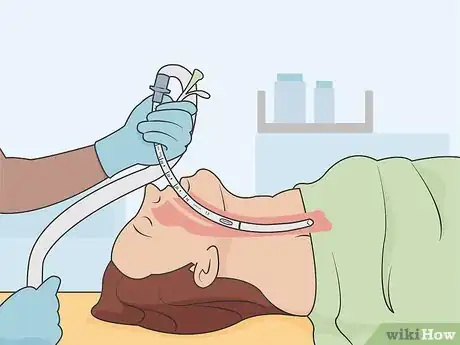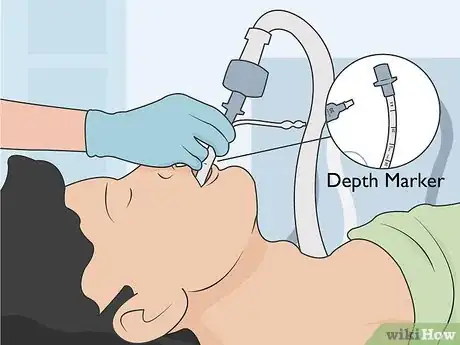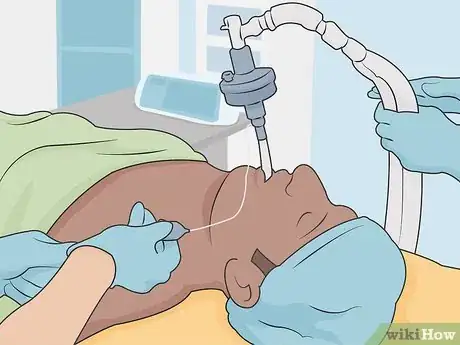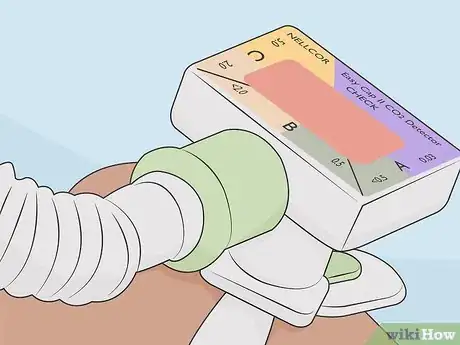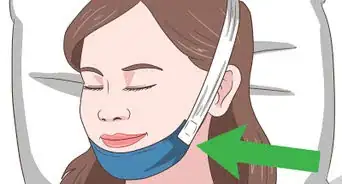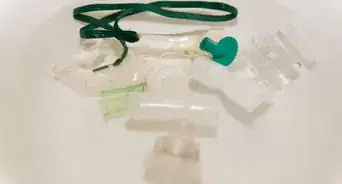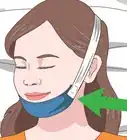This article was medically reviewed by Sarah Gehrke, RN, MS. Sarah Gehrke is a Registered Nurse and Licensed Massage Therapist in Texas. Sarah has over 10 years of experience teaching and practicing phlebotomy and intravenous (IV) therapy using physical, psychological, and emotional support. She received her Massage Therapist License from the Amarillo Massage Therapy Institute in 2008 and a M.S. in Nursing from the University of Phoenix in 2013.
There are 11 references cited in this article, which can be found at the bottom of the page.
This article has been viewed 59,967 times.
An endotracheal (ET) tube is used to help a person breathe. It is placed down the throat and into the trachea through the mouth. In order to position it deeply enough into the trachea, but not so deep that it causes internal injuries, the proper length needs to be determined before it is inserted. This proper length is determined by measuring certain features on a person's body and taking other individual aspects into consideration.[1]
Steps
Matching ET Tube Size to a Patient
-
1Find the size marking on the ET tube. The outside diameter (OD) and internal diameter (ID) of an ET tube should be marked on the side of the tube. Typical ID sizes range from 3.5 mm for small infants to 8.5 mm for adult males.[2]
- In general, when referring to the size of an ET tube, you are talking about the internal diameter. This is because the internal diameter determines the amount of air that can be supplied to the person who has been intubated.
-
2Check the length marking on the ET tube. Smaller ID/OD ET tubes come in shorter lengths, as they are typically used on people who have a shorter distance between their mouth and their trachea. In general, ET tubes sized 7.0-9.0 mm are long enough to insert the tube 20–25 centimetres (7.9–9.8 in) down the throat, although the overall length can vary.
- There are specific length markings along the tube to allow the person inserting it to know how much of the tube is down the throat.
- Some doctors choose to cut the ends of ET tubes so they are a specific length for each patient. This is especially common with pediatric patients, as the lengths required can vary drastically.[3]
Advertisement -
3Base your choice of ET tube size on sex and height in adults. ET tube sizes for people over 18 years old are usually based on the sex of the patient and how tall they are. ET tube sizes 7.0 to 8.0 mm are used for females and 8.0 to 9.0 mm for males. If the person is small in stature, meaning they are around 5 feet (1.5 m) tall, the smaller size is used. If they are bigger in stature, closer to 6 feet (1.8 m) tall, the bigger size is used.[4]
- Remember, the size of ET tubes refers to the internal diameter of the tube.
-
4Use age for picking an ET tube size for infants and children. You need to be careful when sizing an ET tube on a child. Because their bodies are so small, you need to be more exact in your measurements than with adults. With this in mind, size ET tubes based on the child's specific age:[5]
- Newborn: 2.5 - 4.0 mm
- Infant under 6 months: 3.5 - 4.0 mm
- Infant between 6 months and 1 year: 4.0 - 4.5 mm
- Child 1 and 2 years: 4.5 - 5.0 mm
- Child over 2 years: divide the child's age by 4 and add 4 mm
-
5Measure a child with a Broselow tape. In order to get a more individualized measurement for an ET tube, a child's body can be measured with a Broselow tape.[6] This is a specialized tape measure that uses the child's height to assess what size equipment should be used on them, including what size ET tube to use on them.[7]
- To use the Broselow tape, begin by laying it down along the length of the child. The tape itself has color blocks along its length. Determine which color block is at the point where the tape reaches the child's feet. Inside this color block will be instructions for treating that sized child.
-
6Be prepared to change the size of the tube. When intubating someone, it is best to have several ET tubes available at a moment's notice. This will allow you to use a different size if you cannot get the one you chose into the person's trachea.
- Have 2 additional ET tubes available, 1 bigger size and 1 smaller size.[8]
Inserting the ET Tube to the Proper Depth
-
1Insert the ET tube into the trachea. Place the person's head in a neutral position and insert a laryngoscope into their mouth to hold the tongue and pharynx out of the way. Then the ET tube can be inserted down the patient’s throat, past the vocal cords, and into the trachea.
- If the person is not already unconscious, they will need to be sedated before having an ET tube inserted.
-
2Insert the tube until the lower depth marker is at the vocal cords. As you are inserting the tube, you should be able to see where it is going until it gets past the vocal cords. At that point, you need to start watching for the marking near the end of the tube to line up with the vocal cords.[9]
- The mark on the tube indicates the average length an ET tube should go down into the trachea.
-
3Check that the depth marker is at the opening of the mouth. There are length markers all along the length of the tube. When the tube is in place properly in an adult, it should indicate a depth of anywhere from 20 to 25 cm at the corner of the mouth.[10]
- If the mark on the tube is positioned correctly at the vocal cord, the depth marker at the mouth should also be in the correct position.
- Later on, this mark will be an easy way for doctors and nurses to ensure that the tube continues to be in the correct position.
-
4Inflate the cuff to hold the ET tube in place. Once you have inserted the tube to the correct depth, inflate the cuff. This is a balloon at the bottom of the ET tube that holds the tube still in the trachea. It is inflated by attaching a syringe to its port and squeezing in 10 cc of air.
- In addition to holding the tube in place, the cuff keeps liquids out of the lungs. This helps minimize the chance of aspiration while the person is intubated.[11]
Monitoring the Tube’s Pressure and Position
-
1Verify proper insertion. Once you have applied oxygen to the tube, make sure the chest is rising and falling. Then verify that the tube is in the right position. This can be done with an X-ray or an ultrasound.
- The tip of the ET tube should be between 3–7 centimetres (1.2–2.8 in) from the bottom of the trachea.[12]
- The carina is the point at the bottom of the trachea where it splits into the bronchi. You do not want the ET tube to go this far down, as it could damage this area.
-
2Record the position of the ET tube so movement can be identified. Recording the positioning of a tube at insertion will allow you to make sure it hasn’t moved over time. Write down the measurement printed on the tube at a specific position in the mouth, such as at the front teeth or the lips.[13]
- When checking on the patient later, you can ensure that the tube is still in the proper position by referencing this documentation.
-
3Put a CO2 detector on the ET tube. You can also ensure that the tube is inserted correctly by putting a CO2 detector on it. If the detector senses any amount of CO2 being exhaled, it will simply change color. This shows that the patient is receiving oxygen properly, as CO2 is a byproduct expelled only when oxygen is supplied.[14]
- These monitors are single use. When they sense CO2, the face of the monitor changes color irreversibly. Because of this, they are typically used just once right after intubation.
-
4Measure the air pressure in the ET tube. Once the ET tube is in, it's a good idea to measure the amount of pressure being created by respiration through the tube. This can be done with a pressure regulator.
- Measuring the pressure created in the airway will help prevent damage to the trachea and the lungs.
- A safe pressure at the cuff of the ET tube is between 20 and 30 cmH2O.
References
- ↑ https://www.ncbi.nlm.nih.gov/pmc/articles/PMC3237149/
- ↑ https://www.howequipmentworks.com/tracheal_tubes/
- ↑ https://www.merckmanuals.com/medical-calculators/PediatricETTubeSize.htm
- ↑ https://associationofanaesthetists-publications.onlinelibrary.wiley.com/doi/full/10.1111/j.1365-2044.2012.07250.x
- ↑ http://www.fpnotebook.com/Lung/Procedure/EndtrchlTb.htm
- ↑ https://www.ncbi.nlm.nih.gov/pmc/articles/PMC5556295/
- ↑ https://www.ncbi.nlm.nih.gov/pubmed/12088810
- ↑ https://www.merckmanuals.com/medical-calculators/PediatricETTubeSize.htm
- ↑ https://www.ncbi.nlm.nih.gov/pmc/articles/PMC3237149/
About This Article
To measure an ET tube, start by checking the tube for the outside diameter and internal diameter, which should be marked on the side. Then, check the length marking, keeping in mind that a 7-9 millimeter tube is typically long enough to insert 20-25 centimeters down the throat. However, you may want to cut your tube to a length more specific to your patient, which you can adjust based on the sex and height for an adult, or by the age for a child. For example, ET tubes that are 7-8 millimeters in length are typically used for females, while tubes that are 8-9 millimeters in length are better for men. Alternatively, a newborn will do better with a tube that's 2.5-4 millimeters in length. For more tips from our Medical co-author, including how to insert an ET tube to the proper depth, read on!







